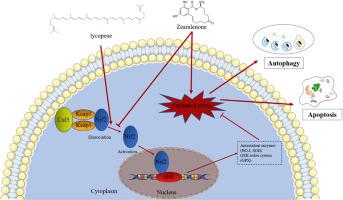Ecotoxicology and Environmental Safety ( IF 6.2 ) Pub Date : 2021-09-03 , DOI: 10.1016/j.ecoenv.2021.112737 Li Cao 1 , Jie Zhao 1 , Li Ma 1 , Jiawen Chen 1 , Jingru Xu 1 , Sajid Ur Rahman 2 , Shibin Feng 1 , Yu Li 3 , Jinjie Wu 3 , Xichun Wang 3

|
Zearalenone (ZEA) has an estrogenic effect and often causes reproductive damage. Pigs are particularly sensitive to it. Lycopene (LYC) is a type of fat-soluble natural carotenoid that has antioxidant, anti-inflammatory, anti-cancer, anti-cardiovascular and detoxifying effects. In this study, piglet sertoli cells (SCs) were used as research objects to investigate the mechanism of ZEA induced damage to piglet SCs and to evaluate the protective effect of LYC on ZEA induced toxic damage to piglet SCs. The results showed that ZEA damaged the cell structure and inhibited the expression of nuclear factor erythroid-2 related factor (Nrf2) in the nucleus, which down-regulated the relative mRNA expression of heme oxygenase 1 (HO-1) and glutathione peroxidase 1 (GPX1) and decreased the activity of HO-1, glutathione peroxidase (GSH-Px) and total superoxide dismutase (T-SOD), resulting in an increase in malondialdehyde (MDA) and reactive oxygen species (ROS) content. ZEA downregulated the relative mRNA and protein expression of bcl-2 in piglet SCs, promoted cell apoptosis, and upregulated the relative mRNA and protein expression of LC3, beclin-1, and bax. After 3 h LYC-pretreatment, ZEA was added for mixed culture. The results of pretreatment with LYC showed that LYC could alleviate the cytotoxicity of ZEA to porlets SCs. Compared with ZEA group, improved the cell survival rate, promoted the expression of Nrf2 in the nucleus, upregulated the relative mRNA expression of HO-1 and GPX1, increased the activity of antioxidant enzymes, and reduced the levels of MDA and ROS. Moreover, after pretreatment with LYC, the mRNA expression of bcl-2 was upregulated, the apoptosis rate was decreased, the relative mRNA and protein expressions of LC3, beclin-1 and bax were downregulated, and autophagy was alleviated. In conclusion, LYC alleviated the oxidative damage of SCs caused by ZEA by promoting the expression of Nrf2 pathway and decreased autophagy and apoptosis.
中文翻译:

番茄红素通过核因子erythroid-2相关因子信号通路减轻玉米赤霉烯酮诱导的仔猪支持细胞氧化损伤
玉米赤霉烯酮 (ZEA) 具有雌激素作用,经常导致生殖损伤。猪对它特别敏感。番茄红素(LYC)是一种脂溶性天然类胡萝卜素,具有抗氧化、抗炎、抗癌、抗心血管和解毒作用。本研究以仔猪支持细胞(SCs)为研究对象,研究ZEA对仔猪SCs损伤的机制,并评价LYC对ZEA诱导仔猪SCs毒性损伤的保护作用。结果表明,ZEA破坏细胞结构,抑制细胞核内核因子erythroid-2相关因子(Nrf2)的表达,下调血红素加氧酶1(HO-1)和谷胱甘肽过氧化物酶1的相对mRNA表达。 GPX1) 并降低 HO-1 的活性,谷胱甘肽过氧化物酶 (GSH-Px) 和总超氧化物歧化酶 (T-SOD),导致丙二醛 (MDA) 和活性氧 (ROS) 含量增加。ZEA下调仔猪SCs中bcl-2的相对mRNA和蛋白表达,促进细胞凋亡,上调LC3、beclin-1和bax的相对mRNA和蛋白表达。LYC预处理3小时后,加入ZEA进行混合培养。LYC预处理的结果表明,LYC可以减轻ZEA对仔猪SCs的细胞毒性。与ZEA组相比,提高细胞存活率,促进细胞核Nrf2的表达,上调HO-1和GPX1的相对mRNA表达,增加抗氧化酶活性,降低MDA和ROS水平。此外,在用 LYC 预处理后,bcl-2 mRNA 表达上调,细胞凋亡率降低,LC3、beclin-1 和bax 的相对mRNA 和蛋白表达下调,自噬减轻。综上所述,LYC通过促进Nrf2通路的表达,减少自噬和凋亡,减轻ZEA引起的SCs的氧化损伤。











































 京公网安备 11010802027423号
京公网安备 11010802027423号